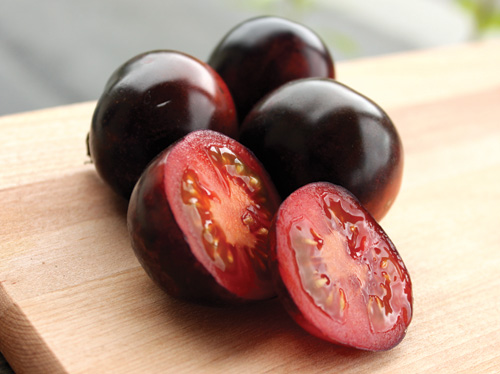 Tomatoes owe their red color to carotenoids, a group of fat-soluble pigments rich in antioxidants. Now scientists at Oregon State University have created a new, purple tomato — “Indigo Rose” — that owes its eggplant color to another class of nutrient-heavy pigments called “anthocyanins.”
Tomatoes owe their red color to carotenoids, a group of fat-soluble pigments rich in antioxidants. Now scientists at Oregon State University have created a new, purple tomato — “Indigo Rose” — that owes its eggplant color to another class of nutrient-heavy pigments called “anthocyanins.”
BY LINDA BAKER
 Tomatoes owe their red color to carotenoids, a group of fat-soluble pigments rich in antioxidants. Now scientists at Oregon State University have created a new, purple tomato — “Indigo Rose” — that owes its eggplant color to another class of nutrient-heavy pigments called “anthocyanins.” The latter have a tenfold-higher level of antioxidants compared to carotenoids, according to Jim Myers, a professor in OSU’s horticulture department. Until recently, tomatoes grown in home gardens had anthocyanins only in their leaves and stems, which are inedible. Indigo Rose, by contrast, contains the pigment in the skin. The catch, says Myers, is the pigment only develops on the part of the fruit that is exposed to sunlight. If shaded by a leaf or on the base, the purple color does not manifest. Anthocyanins are also water-soluble, so they can leach out during cooking. The next step is to identify genes that express the anthocyanins through the entire fruit, says Myers, noting that the tomato-breeding program is helping researchers understand how antioxidants contribute to human health. Home gardeners, he adds, have an insatiable appetite for new and improved tomatoes such as the Indigo Rose, which is now available through seed catalogs. “There’s a whole cult of amateur tomato breeders out there interested in this,” he says.
Tomatoes owe their red color to carotenoids, a group of fat-soluble pigments rich in antioxidants. Now scientists at Oregon State University have created a new, purple tomato — “Indigo Rose” — that owes its eggplant color to another class of nutrient-heavy pigments called “anthocyanins.” The latter have a tenfold-higher level of antioxidants compared to carotenoids, according to Jim Myers, a professor in OSU’s horticulture department. Until recently, tomatoes grown in home gardens had anthocyanins only in their leaves and stems, which are inedible. Indigo Rose, by contrast, contains the pigment in the skin. The catch, says Myers, is the pigment only develops on the part of the fruit that is exposed to sunlight. If shaded by a leaf or on the base, the purple color does not manifest. Anthocyanins are also water-soluble, so they can leach out during cooking. The next step is to identify genes that express the anthocyanins through the entire fruit, says Myers, noting that the tomato-breeding program is helping researchers understand how antioxidants contribute to human health. Home gardeners, he adds, have an insatiable appetite for new and improved tomatoes such as the Indigo Rose, which is now available through seed catalogs. “There’s a whole cult of amateur tomato breeders out there interested in this,” he says.


